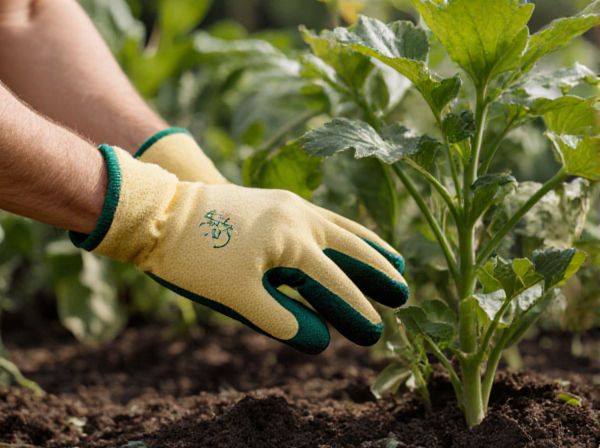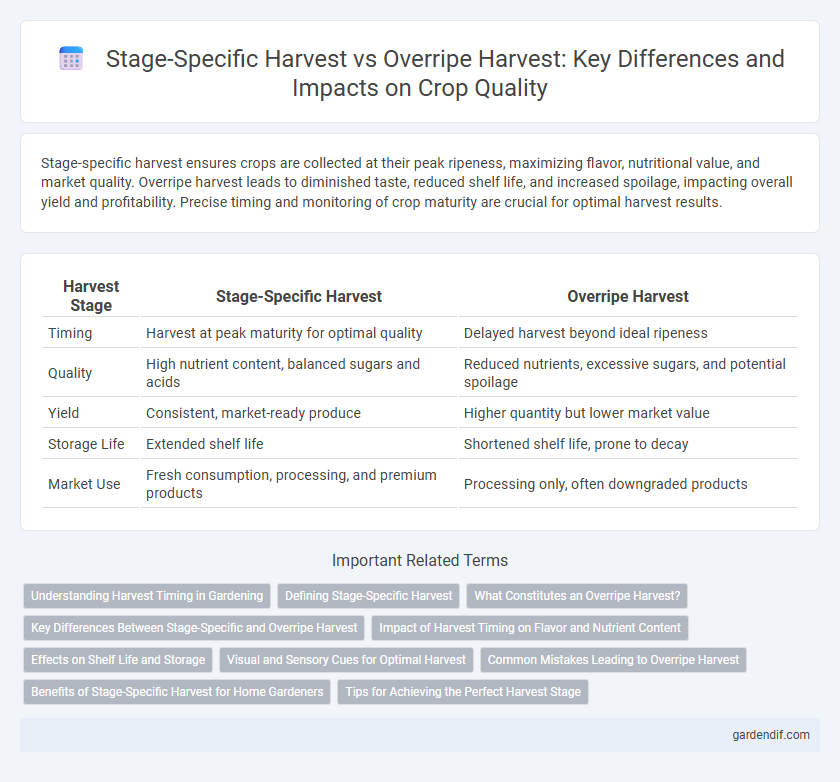
Stage-specific Harvest vs Overripe Harvest Illustration
Stage-specific harvest ensures crops are collected at their peak ripeness, maximizing flavor, nutritional value, and market quality. Overripe harvest leads to diminished taste, reduced shelf life, and increased spoilage, impacting overall yield and profitability. Precise timing and monitoring of crop maturity are crucial for optimal harvest results.
Table of Comparison
| Harvest Stage | Stage-Specific Harvest | Overripe Harvest |
|---|---|---|
| Timing | Harvest at peak maturity for optimal quality | Delayed harvest beyond ideal ripeness |
| Quality | High nutrient content, balanced sugars and acids | Reduced nutrients, excessive sugars, and potential spoilage |
| Yield | Consistent, market-ready produce | Higher quantity but lower market value |
| Storage Life | Extended shelf life | Shortened shelf life, prone to decay |
| Market Use | Fresh consumption, processing, and premium products | Processing only, often downgraded products |
Understanding Harvest Timing in Gardening
Harvest timing in gardening critically affects crop quality, with stage-specific harvest ensuring fruits and vegetables are picked at optimal ripeness for maximum flavor and nutrient content. Overripe harvest often leads to reduced shelf life and increased susceptibility to spoilage or pests, impacting overall yield and market value. Precise timing based on plant maturity indicators and environmental factors enhances productivity and maintains post-harvest quality.
Defining Stage-Specific Harvest
Stage-specific harvest targets crops at their optimal maturity for peak quality and yield, preventing nutrient loss and maximizing flavor. This approach contrasts sharply with overripe harvest, where delayed picking leads to diminished texture, increased spoilage, and reduced market value. Precise timing in stage-specific harvest enhances post-harvest shelf life and supports sustainable agricultural practices by minimizing waste.
What Constitutes an Overripe Harvest?
An overripe harvest occurs when crops exceed their optimal maturity, leading to diminished quality and vulnerability to spoilage. This stage involves excessive sugar accumulation, softer textures, and potential fermentation, impacting flavor and shelf life. Distinguishing between stage-specific harvest and overripe harvest is crucial for maximizing yield quality and minimizing post-harvest losses.
Key Differences Between Stage-Specific and Overripe Harvest
Stage-specific harvest targets crops at their optimal maturity, ensuring maximum nutritional value, flavor, and shelf life, whereas overripe harvest involves gathering produce beyond peak ripeness, often leading to diminished quality and increased susceptibility to spoilage. Stage-specific harvesting requires precise timing and monitoring of physiological indicators like color, firmness, and sugar content, while overripe harvests may prioritize quantity over quality. Understanding these differences is crucial for maximizing post-harvest handling efficiency and marketability.
Impact of Harvest Timing on Flavor and Nutrient Content
Stage-specific harvest ensures optimal flavor and nutrient content by picking crops at peak ripeness when sugars, vitamins, and antioxidants are highest. Overripe harvest leads to nutrient degradation, off-flavors, and increased spoilage due to the breakdown of cellular structures and accumulation of unwanted compounds. Timing harvest according to maturity stages maximizes crop quality and shelf life, enhancing both taste and nutritional value.
Effects on Shelf Life and Storage
Stage-specific harvest ensures fruits and vegetables are picked at optimal maturity, maximizing shelf life and maintaining freshness during storage by reducing spoilage and microbial growth. Overripe harvest results in accelerated ripening and deterioration, significantly decreasing storage potential and increasing susceptibility to mold, bruising, and dehydration. Proper timing of harvest stages is critical for maintaining product quality, extending marketability, and minimizing post-harvest losses.
Visual and Sensory Cues for Optimal Harvest
Stage-specific harvest relies on visual cues such as vibrant color development and firm texture to determine optimal picking time, ensuring peak flavor and nutritional value. Overripe harvest is characterized by dull coloration, soft spots, and fermentation odors, signaling diminished quality and potential spoilage. Sensory cues like aroma intensity and tactile firmness guide farmers in balancing maximum yield with produce freshness.
Common Mistakes Leading to Overripe Harvest
Harvest timing errors often result from misjudging fruit maturity indicators, such as color and firmness, leading to overripe harvests. Ignoring precise stage-specific metrics like sugar content (Brix) and acidity levels can cause premature or delayed picking, adversely affecting crop quality. Failure to monitor environmental factors like temperature and humidity further exacerbates the risk of overripe harvest, reducing shelf life and market value.
Benefits of Stage-Specific Harvest for Home Gardeners
Stage-specific harvest allows home gardeners to pick fruits and vegetables at their optimal ripeness, ensuring the best flavor, nutritional value, and texture in each harvest. This method reduces waste by preventing overripe harvests that often lead to spoilage and pest attraction. Home gardeners benefit from prolonged harvest periods and improved crop yield quality using stage-specific techniques.
Tips for Achieving the Perfect Harvest Stage
Harvesting at the optimal stage ensures peak flavor, nutrient content, and shelf life in fruits and vegetables. To achieve the perfect harvest stage, monitor color, firmness, and sugar levels specific to each crop, using refractometers or visual cues to avoid underripe or overripe picks. Employing consistent timing and environmental assessments reduces waste and maximizes yield quality, distinguishing stage-specific harvest from overripe harvest consequences.
Stage-specific Harvest vs Overripe Harvest Infographic

 gardendif.com
gardendif.com